Synergism between Wnt3a and heparin enhances osteogenesis via a phosphoinositide 3-kinase/Akt/RUNX2 pathway
- PMID: 20547765
- PMCID: PMC2924036
- DOI: 10.1074/jbc.M110.122069
Synergism between Wnt3a and heparin enhances osteogenesis via a phosphoinositide 3-kinase/Akt/RUNX2 pathway
Abstract
A new strategy has emerged to improve healing of bone defects using exogenous glycosaminoglycans by increasing the effectiveness of bone-anabolic growth factors. Wnt ligands play an important role in bone formation. However, their functional interactions with heparan sulfate/heparin have only been investigated in non-osseous tissues. Our study now shows that the osteogenic activity of Wnt3a is cooperatively stimulated through physical interactions with exogenous heparin. N-Sulfation and to a lesser extent O-sulfation of heparin contribute to the physical binding and optimal co-stimulation of Wnt3a. Wnt3a-heparin signaling synergistically increases osteoblast differentiation with minimal effects on cell proliferation. Thus, heparin selectively reduces the effective dose of Wnt3a needed to elicit osteogenic, but not mitogenic responses. Mechanistically, Wnt3a-heparin signaling strongly activates the phosphoinositide 3-kinase/Akt pathway and requires the bone-related transcription factor RUNX2 to stimulate alkaline phosphatase activity, which parallels canonical beta-catenin signaling. Collectively, our findings establish the osteo-inductive potential of a heparin-mediated Wnt3a-phosphoinositide 3-kinase/Akt-RUNX2 signaling network and suggest that heparan sulfate supplementation may selectively reduce the therapeutic doses of peptide factors required to promote bone formation.
Figures

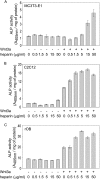
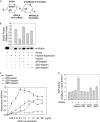
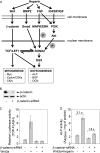
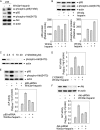
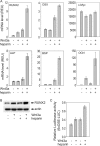
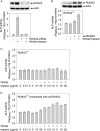


Similar articles
-
Wnt proteins prevent apoptosis of both uncommitted osteoblast progenitors and differentiated osteoblasts by beta-catenin-dependent and -independent signaling cascades involving Src/ERK and phosphatidylinositol 3-kinase/AKT.J Biol Chem. 2005 Dec 16;280(50):41342-51. doi: 10.1074/jbc.M502168200. Epub 2005 Oct 25. J Biol Chem. 2005. PMID: 16251184
-
All-trans retinoic acid modulates Wnt3A-induced osteogenic differentiation of mesenchymal stem cells via activating the PI3K/AKT/GSK3β signalling pathway.Mol Cell Endocrinol. 2016 Feb 15;422:243-253. doi: 10.1016/j.mce.2015.12.018. Epub 2015 Dec 31. Mol Cell Endocrinol. 2016. PMID: 26747727
-
Opposite spectrum of activity of canonical Wnt signaling in the osteogenic context of undifferentiated and differentiated mesenchymal cells: implications for tissue engineering.Tissue Eng Part A. 2010 Oct;16(10):3185-97. doi: 10.1089/ten.tea.2010.0133. Tissue Eng Part A. 2010. PMID: 20590472 Free PMC article.
-
Hyperbaric oxygen promotes osteogenic differentiation of bone marrow stromal cells by regulating Wnt3a/β-catenin signaling--an in vitro and in vivo study.Stem Cell Res. 2014 Jan;12(1):260-74. doi: 10.1016/j.scr.2013.10.007. Epub 2013 Nov 1. Stem Cell Res. 2014. PMID: 24291646
-
Fluoride promotes osteoblastic differentiation through canonical Wnt/β-catenin signaling pathway.Toxicol Lett. 2014 Feb 10;225(1):34-42. doi: 10.1016/j.toxlet.2013.11.029. Epub 2013 Dec 1. Toxicol Lett. 2014. PMID: 24300170
Cited by
-
The effect of salidroside on the bone and cartilage properties in broilers.Poult Sci. 2024 Dec;103(12):104274. doi: 10.1016/j.psj.2024.104274. Epub 2024 Sep 2. Poult Sci. 2024. PMID: 39270480 Free PMC article.
-
Glycans modify mesenchymal stem cell differentiation to impact on the function of resulting osteoblasts.J Cell Sci. 2018 Feb 14;131(4):jcs209452. doi: 10.1242/jcs.209452. J Cell Sci. 2018. PMID: 29361539 Free PMC article.
-
Heparan Sulfate Proteoglycans: Key Mediators of Stem Cell Function.Front Cell Dev Biol. 2020 Nov 19;8:581213. doi: 10.3389/fcell.2020.581213. eCollection 2020. Front Cell Dev Biol. 2020. PMID: 33330458 Free PMC article. Review.
-
A Versatile Macromer-Based Glycosaminoglycan (sHA3) Decorated Biomaterial for Pro-Osteogenic Scavenging of Wnt Antagonists.Pharmaceutics. 2020 Oct 29;12(11):1037. doi: 10.3390/pharmaceutics12111037. Pharmaceutics. 2020. PMID: 33138172 Free PMC article.
-
Mechanistic studies of chondroitin sulfate/dermatan sulfate isolated from freshwater fish discards on osteogenesis in MC3T3-E1 cells.Glycoconj J. 2025 Feb;42(1):15-26. doi: 10.1007/s10719-025-10178-x. Epub 2025 Jan 30. Glycoconj J. 2025. PMID: 39883365
References
-
- Guimond S., Maccarana M., Olwin B. B., Lindahl U., Rapraeger A. C. (1993) J. Biol. Chem. 268, 23906–23914 - PubMed
-
- Ishihara M., Shaklee P. N., Yang Z., Liang W., Wei Z., Stack R. J., Holme K. (1994) Glycobiology 4, 451–458 - PubMed
-
- Jackson R. A., Murali S., van Wijnen A. J., Stein G. S., Nurcombe V., Cool S. M. (2007) J. Cell. Physiol. 210, 38–50 - PubMed
-
- Lee J. Y., Choo J. E., Choi Y. S., Lee K. Y., Min D. S., Pi S. H., Seol Y. J., Lee S. J., Jo I. H., Chung C. P., Park Y. J. (2007) J. Biomed Mater. Res. A 83, 970–979 - PubMed
-
- Ling L., Murali S., Dombrowski C., Haupt L. M., Stein G. S., van Wijnen A. J., Nurcombe V., Cool S. M. (2006) J. Cell. Physiol. 209, 811–825 - PubMed
Publication types
MeSH terms
Substances
Grants and funding
LinkOut - more resources
Full Text Sources
Medical

